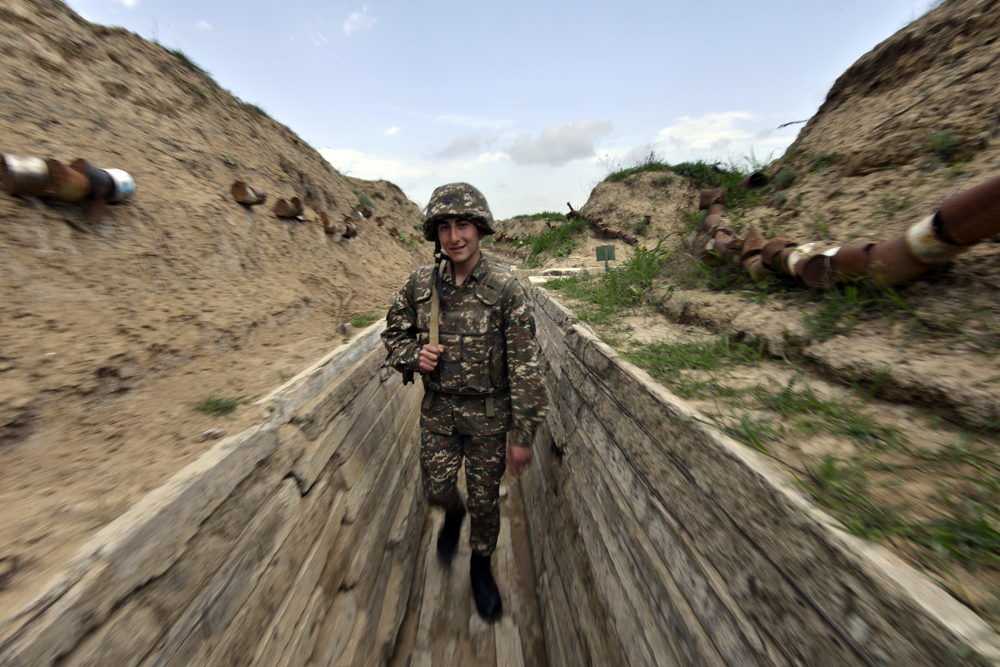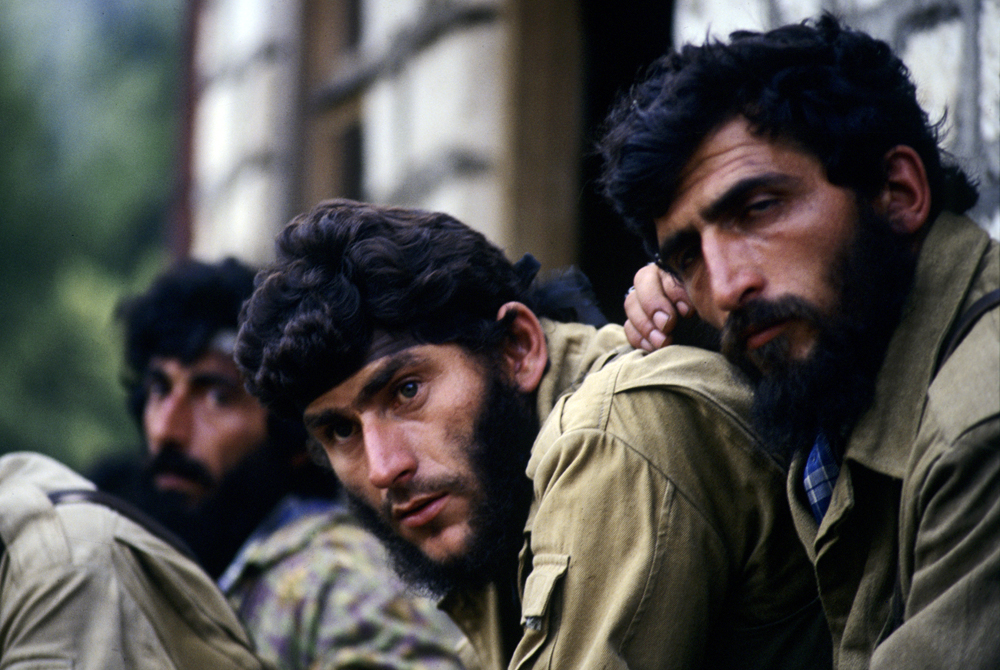Post-Soviet frozen conflicts: What is happening in Russia’s backyard?

A serviceman in the area of the Nagorno-Karabakh conflict, April 7, 2016.
Karo Saakian/RIA NovostiThe recent intensification of the conflict between Azerbaijan and Armenia in Nagorno-Karabakh, as well as the ongoing crisis in the Donbass region of eastern Ukraine, has renewed interest in other unfinished conflicts in post-Soviet countries such as Moldova and Georgia.
While Moscow has played a key role in the “freezing” of each of these territorial conflicts, Russia says that it views these unresolved disputes as a problem that represents a potential threat to its security
The continuous possibility of the renewal of military action in these zones, with the unpredictable consequences this might bring for regional stability, is forcing the Kremlin to think seriously about providing mediation to resolve the "suspended" contradictions between the conflicting sides.
Nagorno-Karabakh
The military clashes that have recently re-erupted in Nagorno-Karabakh have resulted in the death of almost 60 people on both sides in what is the most serious intensification of the conflict since a war over the area ended in 1994.
 The Nagorno-Karabakh War of 1991-1994. Military operations in Martakert district of Nagorno-Karabakh, July 15, 1992. Source: R. Mangasaryan/RIA Novosti
The Nagorno-Karabakh War of 1991-1994. Military operations in Martakert district of Nagorno-Karabakh, July 15, 1992. Source: R. Mangasaryan/RIA Novosti
The original two-year war had been waged for control of the territory that in the days of the USSR was part of Azerbaijan, but which had (and has) a mostly Armenian population. The harsh fighting led to the death of 15,000 people and the establishment of the Nagorno-Karabakh Republic, which is backed by Armenia.
Russian observers say that the conflict in Karabakh was never actually frozen. "There was never a month when someone was not killed, when there was no shooting…" said Sergei Mikheev, head of the Moscow-based Center for Political Affairs. But in the last year the level of violence in the Karabakh conflict zone has significantly increased.
Russian experts believe that currently it is Azerbaijan, which lost the war 20 years ago, that is interested in the escalation of the conflict. Besides the desire to take revenge, Baku, which is heavily dependent on oil revenues, may wish to distract its population from economic difficulties. But there is also the possibility that Ankara is playing a provocative role. Turkey is the only country that supports Azerbaijan unconditionally in the current conflict.
While Russia, which played its role in the bringing the war of 20 years ago to an end as one of the mediators, is now trying to build decent relations with both parties, the fact that Moscow and Yerevan are already allies makes it difficult for Russia to determine which country to support in the conflict.
However, for now Moscow is speaking with both sides and has been able to make certain breakthroughs. Azerbaijani President Ilkham Aliev has stated in a conversation with Russian Foreign Minister Sergei Lavrov that the April 5 armistice agreement in Karabakh was reached thanks to Russian mediation.
Transnistria
The Transnistrian conflict of 1992, another consequence of the USSR's collapse, was shorter and less bloody than that in Karabakh.
The events in Transnistria, a narrow industrial strip of land in Moldova bordering Ukraine with a predominantly Russian population, were a reaction to the declaration of independence by Moldova in 1991.
 Bendery militiamen patrolling the road, July 1, 1992. Source: I. Zenin/RIA Novosti
Bendery militiamen patrolling the road, July 1, 1992. Source: I. Zenin/RIA Novosti
The authorities in Transnistria (Pridnestrovie in Russian) had already declared the creation of the Pridnestrovian Moldovan Republic in 1990 prior to the breakup of the Soviet Union, in response to the fears of the local population concerning the policies of the central government in Chisinau.
The Russian-speaking part of the Moldovan population – mostly the inhabitants of Transnistria – were against what they feared was the creation of a nationalistic Moldovan state seeking to emphasize its Romanian roots and reunite with its western neighbor, from which it had been separated in 1940 when the USSR annexed the region under the secret protocols of the Molotov-Ribbentrop Pact between Stalin and Hitler.
Chisinau tried to solve the problem of uncontrolled Transnistria using force. Military clashes lasted for several months, resulting in hundreds of victims. The conflict ended with a Russia-negotiated ceasefire, and Moscow sent in a contingent of “peacekeepers,” which is still based there. The unrecognized Pridnestrovian Moldovan Republic has now existed for almost a quarter of a century.
Observers say that lately there have been growing tensions in Transnistria, however this has not resulted in an armed conflict. The deterioration of the situation is taking place against the backdrop of the events in Ukraine, with the pro-Russian mood in Transnistria hostage to the crisis in relations between Moscow and Kiev.
In September 2015 Ukraine tried to organize a transportation blockade of the region from its side. Vladimir Yevseyev from the Moscow-based CIS Institute remarks that both Ukraine and Moldova are creating economic problems for Transnistria.
The Russian Foreign Ministry says that the Moldovan government, which is seeking closer ties with the EU, is trying to push the Russian peacekeepers out of Transnistria by replacing them with a sort of civil mission. Moscow believes that this is leading to the growth of tensions in the republic.
Abkhazia and South Ossetia
The Abkhazia and South Ossetia conflicts resemble each other: neither of the two ethnic groups wanted to be part of Georgia. As a response to the course toward independence that Tbilisi had taken in the last years of the USSR, Abkhazia declared itself a sovereign state. South Ossetia also declared itself a sovereign state. Earlier, South Ossetia had even tried raising its status to an autonomous republic within Soviet Georgia.
 Residents of Dzhava village organizing a self-defense group to protect their families and refugees from nearby communities, April 1, 1991. Source: Sergey Titov/RIA Novosti
Residents of Dzhava village organizing a self-defense group to protect their families and refugees from nearby communities, April 1, 1991. Source: Sergey Titov/RIA Novosti
In both cases the confrontation between the republican center and the borderlands led to military action. In the case of Abkhazia (1992-1993) the conflict was longer and contained more bloodshed, producing 14,000-16,000 victims, while the conflict in South Ossetia (1991-1992) resulted in fewer than 1,000 deaths. Russian peacekeepers, who in South Ossetia were part of a joint force alongside Georgian and South Ossetian counterparts, were introduced after the end of both conflicts.
In August 2008, following a series of tit-for-tat skirmishes between Georgian troops and South Ossetian separatists, as well as bombings and mortar attacks, Georgian forces launched an assault on the Russian-backed region, advancing to the regional capital of Tskhinvali in an attempt to swiftly capture the town and block Russian troops from coming to the South Ossetians’ aid through the Roki tunnel from Russia. However, Russian and South Ossetian peacekeepers were able to hold up the Georgians for long enough for Russian reinforcements to arrive.
One of the results of the subsequent five-day war between Russia and Georgia was the deployment of Russian troops in South Ossetia and Abkhazia and Moscow's recognition of the territories as sovereign nations – though just three states (Nicaragua, Venezuela – and the Pacific islet of Nauru in the case of South Ossetia) have followed suit, with the West still viewing them as part of a sovereign Georgia.
In 2015 an alliance and strategic partnership agreement came into effect between Russia and Abkhazia, while Russia signed an agreement on cooperation and integration with South Ossetia.
In comparison to Karabakh and Transnistria, Abkhazia and South Ossetia are in a more stable position since they are now practically Russian protectorates.
Subscribe to get the hand picked best stories every week
All rights reserved by Rossiyskaya Gazeta.
Subscribe
to our newsletter!
Get the week's best stories straight to your inbox

